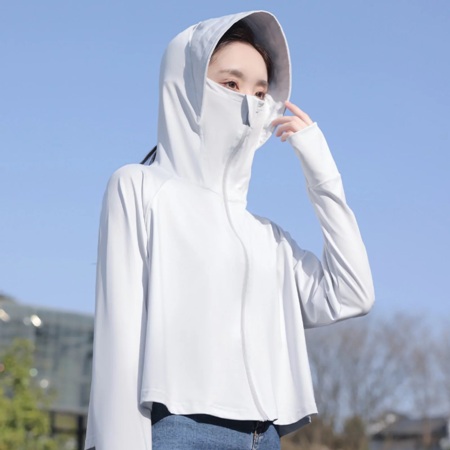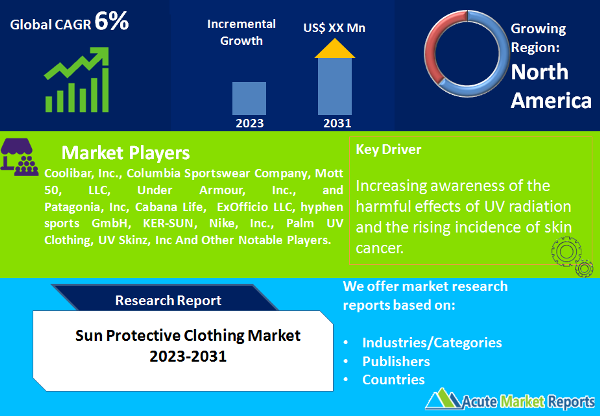
The sun-protective clothing market has witnessed positive growth in recent years, driven by increasing awareness of the harmful effects of UV radiation and the rising incidence of skin cancer. Sun-protective clothing offers an effective solution to protect the skin from harmful UV rays, reducing the risk of sunburn, skin aging, and skin cancer. The market is expected to continue its growth trajectory, with a projected CAGR of 6% during the forecast period of 2024 to 2032. Several factors contribute to the market's expansion, including growing health consciousness, advancements in fabric technology, and government initiatives promoting sun safety. However, certain restraints, such as limited consumer awareness and the high cost of specialized sun-protective clothing, may hinder market growth.

Growing Health Consciousness
The rising awareness of the detrimental effects of UV radiation on skin health has led to increased health consciousness among individuals. Consumers are becoming more proactive in taking measures to protect their skin from sun damage, fueling the demand for sun-protective clothing. The desire to maintain healthy skin and prevent skin-related ailments, such as sunburn and skin cancer, has become a significant driver for the sun-protective clothing market. Moreover, healthcare professionals and dermatologists have been advocating the use of sun-protective clothing as an essential component of sun protection strategies. The wide range of sun-protective clothing available, suitable for various activities and lifestyles, has further contributed to its popularity among health-conscious consumers.
Advancements in Fabric Technology
Advancements in fabric technology have played a vital role in driving the growth of the sun-protective clothing market. Manufacturers are continuously innovating to develop fabrics with enhanced UV protection capabilities. High-performance fabrics with UPF (Ultraviolet Protection Factor) ratings are engineered to block harmful UV radiation effectively. The incorporation of UV-absorbing agents, special dyes, and sun-blocking additives in the fabric allows for higher UV protection without compromising comfort and breathability. Additionally, moisture-wicking properties and lightweight designs have made sun-protective clothing more comfortable for outdoor activities, further bolstering its demand.
Government Initiatives Promoting Sun Safety
Government initiatives and public health campaigns focused on sun safety have contributed to the growth of the sun-protective clothing market. Many countries have launched awareness campaigns to educate the public about the importance of sun protection and the benefits of using sun-protective clothing. In some regions, employers in outdoor industries are required to provide sun-protective clothing to workers to safeguard them from occupational sun exposure. Moreover, educational institutions and sports organizations have also embraced sun safety measures, recommending or mandating the use of sun-protective clothing during outdoor activities.
Limited Consumer Awareness and High Cost
Despite the growing awareness of sun protection, limited consumer awareness about the benefits and availability of sun-protective clothing remains a significant restraint. Many consumers still rely solely on traditional sunscreens for sun protection and may not be aware of the additional protection offered by sun-protective clothing. Moreover, specialized sun-protective clothing can be relatively expensive compared to regular clothing, especially for high-quality UPF-rated fabrics. The perception of higher cost may deter some price-sensitive consumers from investing in sun-protective clothing, limiting its market penetration.
Market Segmentation by Product: Top Wear and Swimwear Segments Dominate the Market
The sun protective clothing market is segmented by product into top wear, bottom wear, scarves, bandanas & sun hats, swimwear, and others. In 2023, top wear and swimwear segments dominated the market in terms of revenue, Top wear, including shirts, t-shirts, and blouses with built-in sun protection, accounted for a significant share of the sun protective clothing market in 2023. The top wear segment is popular among consumers for its versatility, as it can be easily integrated into everyday wear. Sun protective top wear offers broad coverage to the upper body, effectively shielding the shoulders, back, and chest from harmful UV radiation. The availability of various styles, colors, and fabric options has made sun protective top wear fashionable and appealing to a wide range of consumers. The rising adoption of sun protective top wear in outdoor activities, leisure, and sports has bolstered its market demand. The scarves, bandanas & sun hats segment exhibited the highest CAGR during the forecast period of 2024 to 2032. The scarves, bandanas, and sun hats segment exhibited the highest CAGR during the forecast period of 2024 to 2032. These accessories are versatile additions to sun protection attire, offering flexibility in protecting specific areas of the body, such as the neck, face, and head. Scarves and bandanas can be easily wrapped around the neck and face to shield against UV radiation. Sun hats with wide brims provide shade to the face and neck, offering an additional layer of protection against the sun.
Market Segmentation by UPF Rating: UPF 40 - 50+ Dominates the Market
The market is further segmented by UPF rating into "up to UPF 30," "UPF 30 - 39," and "UPF 40 - 50+." In 2023, the "UPF 40 - 50+" segment dominated the market in terms of revenue. The "UPF 40 - 50+" segment offers the highest level of sun protection, effectively blocking more than 98% of UV radiation. Sun-protective clothing in this category is specifically engineered to provide superior UV shielding, making it ideal for individuals with higher sun sensitivity or those exposed to intense sunlight for extended periods. The "UPF 30 - 39" segment exhibited the highest CAGR during the forecast period of 2024 to 2032. The "UPF 30 - 39" segment encompasses clothing with good to very good UV protection, blocking approximately 97% of UV radiation. This category of sun-protective clothing is suitable for everyday wear and outdoor activities where moderate sun protection is required.
North America Remains as the Global Leader
North America led the sun protective clothing market in terms of revenue in 2023, driven by the region's high skin cancer incidence and strong awareness campaigns promoting sun safety. Additionally, the demand for sun-protective clothing is bolstered by outdoor recreational activities and beach tourism in North America. The Asia-Pacific region is anticipated to experience the highest CAGR during the forecast period of 2024 to 2032. Factors such as the increasing prevalence of skin cancer, rising disposable income, and growing health consciousness are expected to drive market growth in the Asia-Pacific region.
Market Competition to Intensify during the Forecast Period
The sun-protective clothing market is characterized by intense competition among key players striving to capture a larger market share. Some of the top players in the market include Coolibar, Inc., Columbia Sportswear Company, Mott 50, LLC, Under Armour, Inc., and Patagonia, Inc, Cabana Life, ExOfficio LLC, hyphen sports GmbH, KER-SUN, Nike, Inc., Palm UV Clothing, UV Skinz, Inc To maintain their market position, these players focus on product innovation, expanding their product portfolios, and leveraging strategic partnerships to enhance their market presence. The continuous development of advanced fabrics with higher UPF ratings and the incorporation of innovative design elements further strengthen their competitive edge. As of 2023, the sun-protective clothing market has exhibited robust growth, and these top players have capitalized on market opportunities. Looking ahead to the forecast period from 2024 to 2032, it is expected that these players will continue to dominate the market and drive its growth through continued innovation and strategic initiatives.
Historical & Forecast Period
This study report represents analysis of each segment from 2022 to 2032 considering 2023 as the base year. Compounded Annual Growth Rate (CAGR) for each of the respective segments estimated for the forecast period of 2024 to 2032.
The current report comprises of quantitative market estimations for each micro market for every geographical region and qualitative market analysis such as micro and macro environment analysis, market trends, competitive intelligence, segment analysis, porters five force model, top winning strategies, top investment markets, emerging trends and technological analysis, case studies, strategic conclusions and recommendations and other key market insights.
Research Methodology
The complete research study was conducted in three phases, namely: secondary research, primary research, and expert panel review. key data point that enables the estimation of Sun Protective Clothing market are as follows:
Market forecast was performed through proprietary software that analyzes various qualitative and quantitative factors. Growth rate and CAGR were estimated through intensive secondary and primary research. Data triangulation across various data points provides accuracy across various analyzed market segments in the report. Application of both top down and bottom-up approach for validation of market estimation assures logical, methodical and mathematical consistency of the quantitative data.
| ATTRIBUTE | DETAILS |
|---|---|
| Research Period | 2022-2032 |
| Base Year | 2023 |
| Forecast Period | 2024-2032 |
| Historical Year | 2022 |
| Unit | USD Million |
| Segmentation | |
Product
| |
UPF Rating
| |
Consumer Group
| |
Distribution Channel
| |
Size
| |
Pricing
| |
|
Region Segment (2022-2032; US$ Million)
|
Key questions answered in this report